Blush Macaranga, Heart Leaf
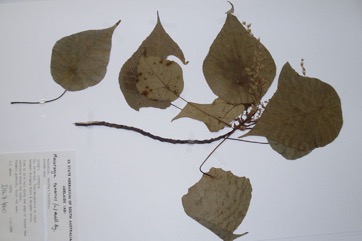
A tropical plant. It is native from Malaysia to Australia. It will grow in many types of soil. The soil should be well-drained. It does best in a sunny position. Common and widely distributed in open places and secondary forest throughout the Philippines. In Borneo it grows up to 1,400 m above sea level. It can be near beaches and along tidal streams. It is mostly on sandy or rocky soils.
Also known as:
Binunga, Brush Macaranga, Butsu veene, Hairy Mahang, Kakat, Kamala, Limboga, Lingkobong, Melang kabau, Naupata, Pada, Parasol leaf tree, Sedaman, Singkabong, Tubbig, Venu, Venue, Wenurapi
Synonyms
- Croton lacciferus Blanco
- Macaranga molliuscula Kurz
- Mappa moluccana Wight
- Mappa tanarius (L.) Blume
- Mappa tomentosa Blume
- Ricinus tanarius L.
- Rottlera tanarius (L.) Hassk.
- Rottlera tomentosa (Blume) Hassk.
Edible Portion
- Bark, Fruit, Leaves - for drink, Seeds
Where does Blush Macaranga grow?
Found in: Asia, Australia, Brunei, Cambodia, China, Christmas Island, East Timor, Hawaii, India, Indonesia, Japan, Laos, Malaysia, Myanmar, Pacific, Papua New Guinea, PNG, Philippines, SE Asia, Solomon Islands, Taiwan, Thailand, Timor-Leste, Vanuatu, Vietnam
Notes: There are about 280 Macaranga species.
Growing Blush Macaranga, Heart Leaf
Cultivation: Plants are grown from seed. Seed should be planted fresh. Seed germinate easily. Plants can be grown from cuttings. The cuttings should be large.
Edible Uses: The bark, leaves and fruit are used in fermenting a drink known as "basi" in the Philippines. The seeds are roasted and added to sugarcane wine.
Production: It is a fast growing plant. In Australia, plants flower in October to December and fruit from January to February.
Nutrition Info
per 100g edible portion| Edible Part | Energy (kcal) | Protein (g) | Iron (mg) | Vitamin A (ug) | Vitamin c (mg) | Zinc (mg) | % Water |
|---|---|---|---|---|---|---|---|
| - | - | - | - | - | - |
Blush Macaranga, Heart Leaf Photos

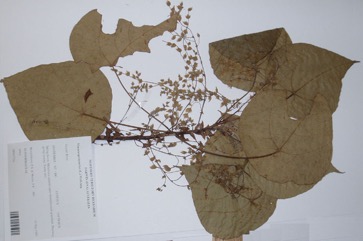
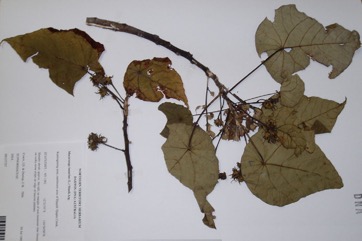
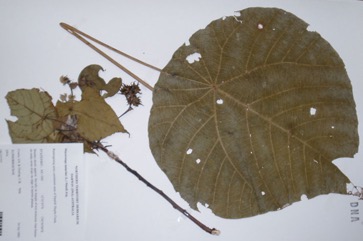
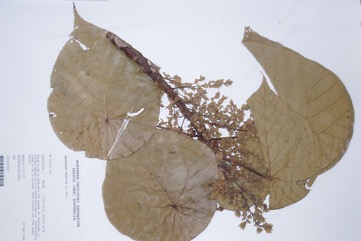
References
Ambasta, S.P. (Ed.), 2000, The Useful Plants of India. CSIR India. p 345
Barwick, M., 2004, Tropical and Subtropical Trees. A Worldwide Encyclopedic Guide. Thames and Hudson p 258
Beasley, J., 2011, Plants of Tropical North Queensland - the compact guide. Footloose publications. p 52
Bodkin, F., 1991, Encyclopedia Botanica. Cornstalk publishing, p 663
Bodner, C. C. and Gereau, R. E., 1988, A Contribution to Bontoc Ethnobotany. Economic Botany, 43(2): 307-369
Brown, W.H., 1920, Wild Food Plants of the Philippines. Bureau of Forestry Bulletin No. 21 Manila. p 88
Cabalion, P. and Morat, P., 1983, Introduction le vegetation, la flore et aux noms vernaculaires de l'ile de Pentcoste (Vanuatu), In: Journal d'agriculture traditionnelle et de botanique appliquee JATBA Vol. 30, 3-4
Calvert, G., 2010, The Burdekin Delta Tree Guide. Lower Burdekin Landcare Association., Inc., Ayr p 117
Cooper, W. and Cooper, W., 2004, Fruits of the Australian Tropical Rainforest. Nokomis Editions, Victoria, Australia. p 189
Cronin, L., 1989, The Concise Australian Flora. Reed. p 156
A. L. P. P. de Candolle, Prodr. 15(2):997. 1866
Elliot, W.R., & Jones, D.L., 1993, Encyclopedia of Australian Plants suitable for cultivation. Vol 6. Lothian. p 267 (Drawing)
Facciola, S., 1998, Cornucopia 2: a Source Book of Edible Plants. Kampong Publications, p 101
Hibbert, M., 2002, The Aussie Plant Finder 2002, Florilegium. p 188
Jackes, B.R., 2001, Plants of the Tropics. Rainforest to Heath. An Identification Guide. James Cook University. p 53
Jones D, L, 1986, Ornamental Rainforest Plants in Australia, Reed Books, p 185
Kuo, W. H. J., (Ed.) Taiwan's Ethnobotanical Database (1900-2000), http://tk.agron.ntu.edu.tw/ethnobot/DB1.htm
Levitt, D., 1981, Plants and people. Aboriginal uses of plants on Groote Eylandt. Australian Institute of Aboriginal Studies, Canberra. p 95
Melzer, R. & Plumb, J., 2011, Plants of Capricornia. Belgamba, Rockhampton. p 126
Monsalud, M.R., Tongacan, A.L., Lopez, F.R., & Lagrimas, M.Q., 1966, Edible Wild Plants in Philippine Forests. Philippine Journal of Science. p 465
Nicholson, N & H., 1996, Australian Rainforest Plants, Terania Rainforest Publishing. NSW. p 43
Peekel, P.G., 1984, (Translation E.E.Henty), Flora of the Bismarck Archipelago for Naturalists, Division of Botany, Lae, PNG. p 307, 306
Ratcliffe D & P., 1987, Australian Native Plants for Indoors. Little Hills press. p 104
Recher, P, 2001, Fruit Spirit Botanical Gardens Plant Index. www.nrg.com.au/~recher/ seedlist.html p 6
Slik, F., www.asianplant.net
Sukarya, D. G., (Ed.) 2013, 3,500 Plant Species of the Botanic Gardens of Indonesia. LIPI p 371
Townsend, K., 1994, Across the Top. Gardening with Australian Plants in the tropics. Society for Growing Australian Plants, Townsville Branch Inc. p 289
Williams, J.B., Harden, G.J., and McDonald, W.J.F., 1984, Trees and shrubs in rainforests of New South Wales and Southern Queensland. Univ. of New England, Armidale. p 65
World Checklist of Useful Plant Species 2020. Royal Botanic Gardens, Kew
www.worldagroforestrycentre.org/treedb/